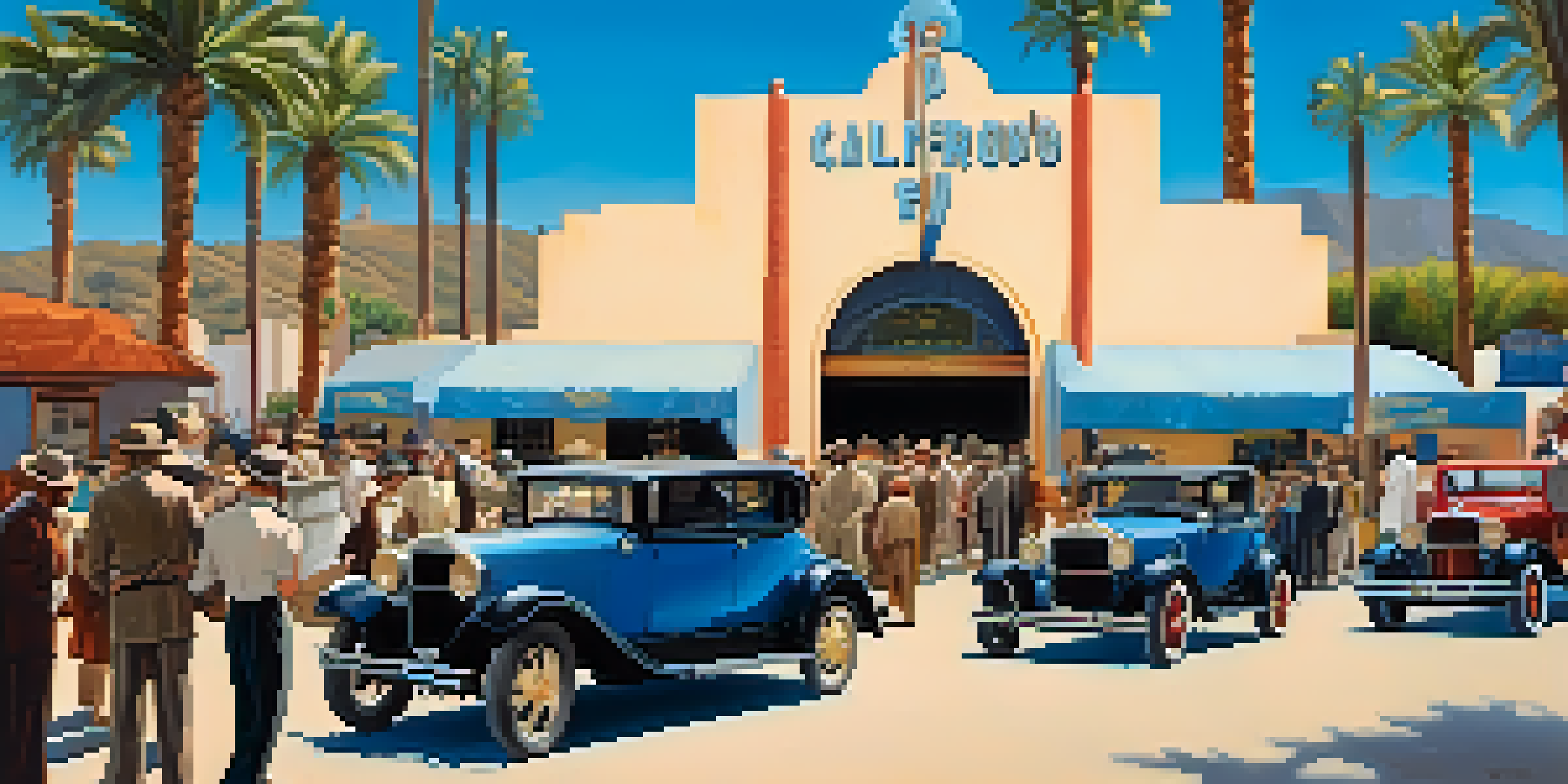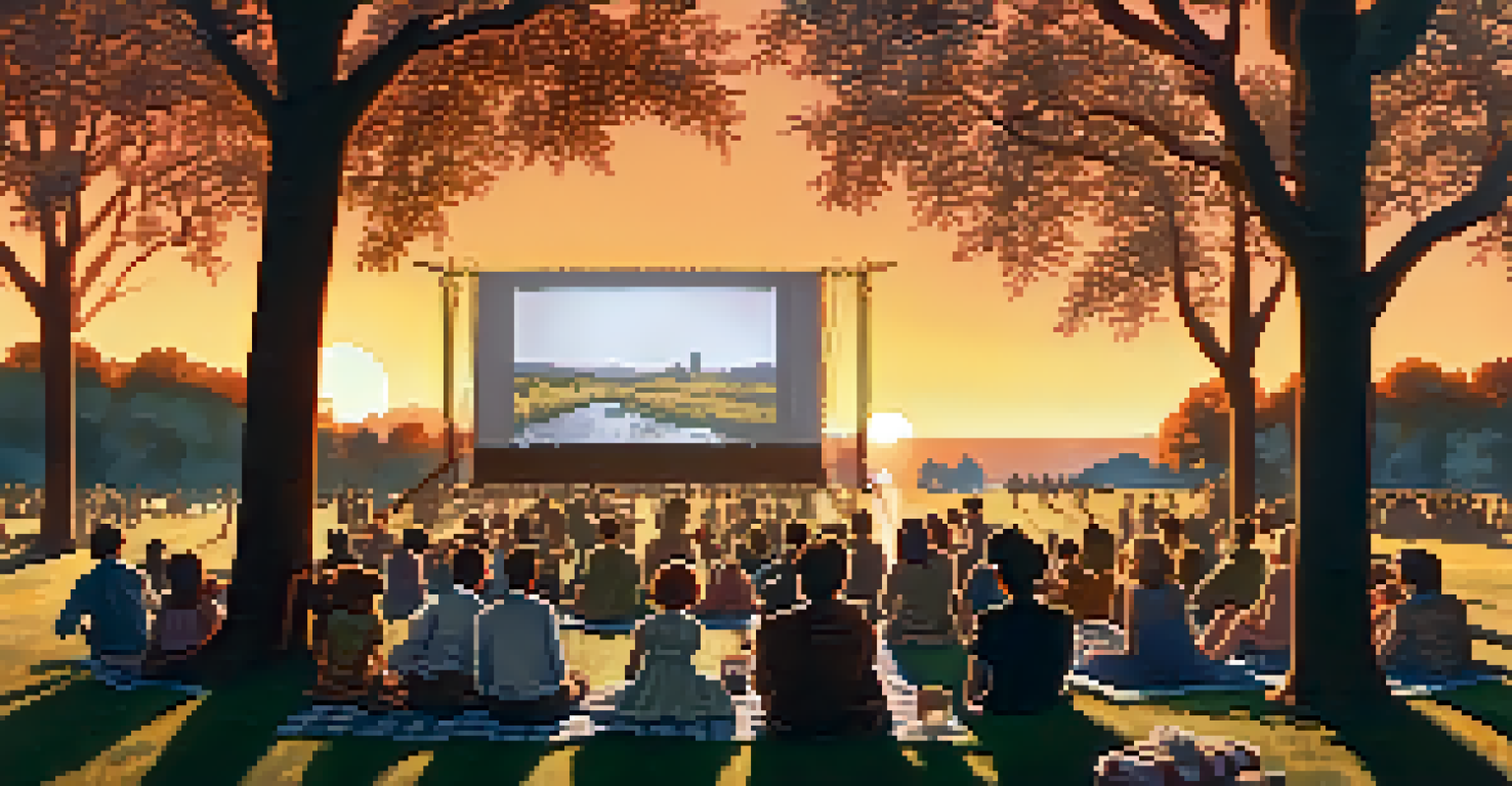Silent Film Era: California's Impact on Global Cinema

The Birth of Silent Cinema in California
The silent film era began in the late 19th century, but it was California that transformed it into a thriving industry. With its picturesque landscapes and diverse locations, filmmakers flocked to the Golden State to capture visual stories. Cities like Los Angeles emerged as the epicenter of this new artistic movement, providing the perfect backdrop for silent films.
Silent films were the first true form of cinematic storytelling, relying solely on visual cues to convey emotion and narrative.
Studios began to sprout like wildflowers across California, with pioneers such as Thomas Edison and D.W. Griffith leading the charge. They established the framework for what would become Hollywood, the heart of the global film industry. The allure of California's sunshine and scenery made it an irresistible destination for filmmakers seeking to create captivating narratives.
As silent films gained popularity, they began to attract large audiences, paving the way for future cinematic innovations. This era laid the groundwork for a unique storytelling style that relied heavily on visual expression. The enchantment of silent films captured the imagination of millions, igniting a passion for cinema that resonates to this day.
Iconic Silent Film Stars from California
The silent film era introduced audiences to a range of unforgettable stars, many of whom hailed from California. Figures like Charlie Chaplin and Buster Keaton became household names, captivating viewers with their comedic genius and physicality. Their performances not only entertained but also set the standards for acting in cinema.

Hollywood became a magnet for talent, with aspiring actors and actresses flocking to the burgeoning industry. The rise of the 'star system' meant that these individuals often became larger-than-life figures, shaping public perception of film and its stars. These icons paved the way for future generations, demonstrating the power of performance in storytelling.
California's Role in Silent Cinema
California transformed silent filmmaking into a booming industry, becoming the heart of the global film movement.
As these stars made their mark, they also influenced global cinema, inspiring filmmakers around the world. Their unique styles and approaches to acting transcended language barriers, allowing silent films to communicate universally. This cross-pollination of ideas helped establish California as a focal point in the evolution of cinema.
Innovative Filmmaking Techniques of the Era
The silent film era was not just about great performances; it was also a time of groundbreaking innovation in filmmaking techniques. Directors experimented with camera angles, lighting, and editing to enhance storytelling, often using creative methods to convey emotions without spoken dialogue. These innovations laid the foundation for the modern film techniques we see today.
The great silent films were a visual poetry that spoke to the world, transcending language and culture.
One notable example is the use of intertitles, which provided context and dialogue in a clever way, allowing audiences to follow the story more easily. Filmmakers also began to incorporate visual effects and elaborate sets, pushing the boundaries of what was possible on screen. This period was a creative playground for directors and cinematographers alike.
The techniques developed during this time not only influenced American cinema but also resonated globally. Filmmakers across the world adopted and adapted these methods, creating a rich tapestry of cinematic language. The legacy of these innovations is evident in contemporary filmmaking, underscoring California’s lasting impact on the art of cinema.
The Role of Music in Silent Films
While silent films lacked spoken dialogue, they were not devoid of sound; music played a crucial role in enhancing the emotional depth of the narrative. The era saw the rise of live orchestras accompanying film screenings, providing a dynamic soundscape that complemented the visuals. This synergy between music and film helped to elevate the overall viewing experience.
Composers began to recognize the importance of scoring for silent films, crafting pieces that would evoke specific emotions. Certain melodies became synonymous with iconic scenes, leaving an indelible mark on audiences. This practice laid the groundwork for the film scores we enjoy in modern cinema, where music continues to be a vital component.
Silent Film Stars Shaped Cinema
Iconic stars like Charlie Chaplin and Buster Keaton captivated audiences and established the foundation for modern acting.
The integration of music into silent films also inspired future generations of filmmakers to explore sound in innovative ways. As the industry transitioned to talkies, the sophistication of film scores evolved, reflecting the complex narratives being told. California’s influence on film music has continued to resonate, shaping how stories are told on screen.
Cultural Influence of California's Silent Films
Silent films produced in California offered a window into society's values, aspirations, and struggles during a transformative period in history. The stories depicted a range of themes, from romance and adventure to social issues, allowing audiences to reflect on their own lives. This cultural impact extended far beyond American borders, influencing filmmakers worldwide.
As these films circulated globally, they challenged societal norms and sparked conversations about various topics. For instance, films often addressed issues of class, gender, and race, pushing the boundaries of what could be discussed openly. This created a dialogue that resonated with audiences from diverse backgrounds, highlighting the universal nature of human experiences.
The cultural significance of California’s silent films can still be felt today, as many of the themes explored remain relevant. The legacy of these films continues to inspire filmmakers to tackle pressing social issues through their work. California's influence on global cinema thus extends beyond technique and style; it has shaped cultural conversations across generations.
The Transition to Sound and Its Global Impact
The advent of sound in film marked a major shift in the cinematic landscape, but the foundation laid during the silent film era was crucial to this transition. California's filmmakers were at the forefront of this change, experimenting with sound technology and integrating it into their productions. This evolution not only transformed the way stories were told but also altered the industry dynamics significantly.
The introduction of sound brought new challenges and opportunities, as filmmakers had to adapt to the technological advancements. The allure of 'talkies' quickly captivated audiences, leading to a decline in silent films. However, many silent film stars successfully transitioned to sound, showcasing their talents in a new format and further solidifying California's role in global cinema.
Innovations Set Stage for Sound Films
Filmmaking techniques developed during the silent era laid the groundwork for the transition to sound, influencing global cinema.
This shift also had a ripple effect across the world, as countries began to embrace sound technology in filmmaking. The techniques and styles pioneered during the silent era provided a solid foundation for sound films, demonstrating California's influence on the global film industry. The legacy of this transition continues to shape how films are produced and enjoyed today.
Preserving the Legacy of Silent Films Today
As we look back on the silent film era, preserving its legacy has become essential for understanding cinema's evolution. Organizations and film archives across California work tirelessly to restore and maintain silent films, ensuring that these historical treasures are accessible to future generations. This preservation effort highlights the importance of celebrating our cinematic roots.
Film festivals dedicated to silent films have emerged, providing platforms for both classic screenings and contemporary interpretations. These events allow audiences to appreciate the artistry of silent cinema while also encouraging new works inspired by that era. Such initiatives help keep the spirit of silent films alive and relevant in today's fast-paced media landscape.

The continued interest in silent films serves as a reminder of California's vital role in shaping global cinema. By fostering an appreciation for this unique art form, we honor the creativity and innovation that defined the silent film era. In doing so, we ensure that the stories and techniques developed continue to inspire filmmakers and audiences alike.